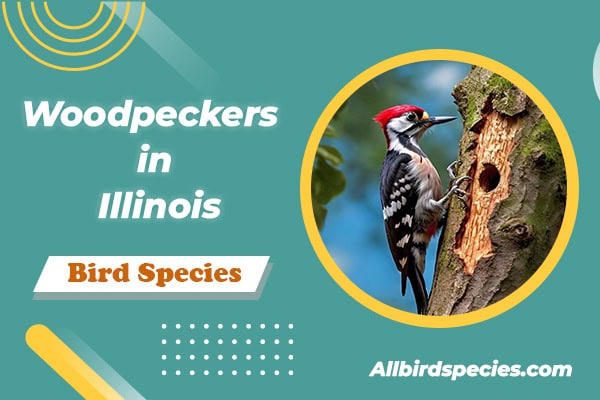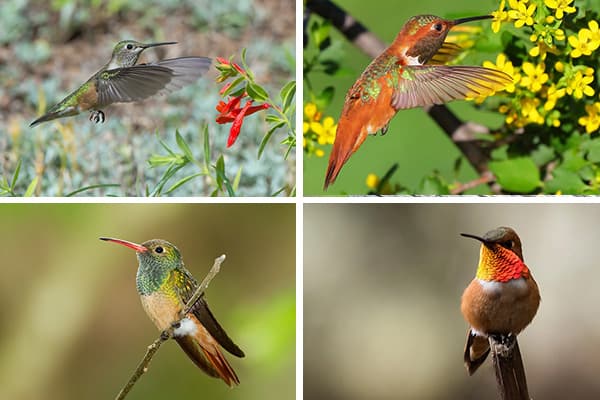11 Types of Woodpeckers in Washington (With Pictures)
I’ve researched Woodpeckers in Washington extensively. Washington state boasts diverse woodpecker species like the Northern Flicker, Downy Woodpecker, Hairy Woodpecker, and Pileated Woodpecker. Even in DC, you’ll spot these fascinating birds. Among them, the Downy Woodpecker often steals the show as one of the most frequently seen across North America. Woodpeckers aren’t rare sights, especially in wooded areas, where their drumming sounds and tree-foraging habits make them easy to find.
Here we’ll learn about 11 different types of Woodpecker in Washington
1. Downy Woodpecker
- Scientific name – Dryobates pubescens
- Lifespan – 2 years (average)- 11 years (maximum recorded)
- Size – 5.5 to 6.7 in
- Weight – 0.7 to 1 oz
- Wingspan – 9.8 to 11.8 in
- Status – Least concern
The Downy Woodpecker is small in North America. It has a white underside, black back, and white spots on its wings. Its head and neck have black and white stripes, and it has white outer tail feathers with dark spots. Male Downy Woodpeckers have a red patch on the back of their heads, which females don’t have.

Downy Woodpeckers make loud, whinnying sounds that get lower in pitch. They also make a “pik” sound.
These woodpeckers in Washington nest in fence posts, dead trees, and dead parts of live trees. They make new nesting holes every year on the undersides of branches. Female Downy Woodpeckers lay three to eight eggs, which hatch after 12 days. The baby birds stay in the nest for 18 to 21 days after hatching.
Downy Woodpeckers eat insects like ants, beetle larvae, caterpillars, and corn earworms. They also eat acorns, grains, and berries.
2. Hairy Woodpecker
- Scientific name – Dryobates villosus
- Lifespan – 10 years (average)- 15 years (maximum recorded)
- Size – 7.1 to 10.2 in
- Weight – 1.4 to 3.4 oz
- Wingspan – 13 to 16.1 in
- Status – Least concern
The Hairy Woodpecker is a medium-sized woodpecker that looks a lot like the Downy Woodpecker. They have white undersides, black backs, white spots on their wings, and black and white stripes on their heads. Male Hairy Woodpeckers have a red patch on the back of their heads, which females don’t have. Unlike the Downy Woodpecker, Hairy Woodpeckers have plain white outer tail feathers.
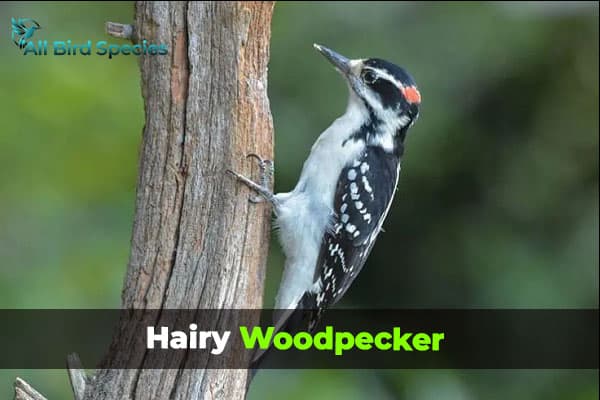
Hairy Woodpeckers make a short “peek” call and a longer whinnying call.
They nest in dead parts of live trees or dead trees, creating new nesting cavities each breeding season. Female Hairy Woodpeckers lay three to six eggs, which hatch after 11 to 12 days. The baby birds stay in the nest for 28 to 30 days after hatching.
Hairy Woodpeckers mainly eat pupae and larvae of bark beetles, woodboring beetles, ants, moths, caterpillars, bees, and wasps, which make up about three-quarters of their diet. They also eat spiders, fruit, seeds, and millipedes.
3. Pileated Woodpecker
- Scientific name – Dryocopus pileatus
- Lifespan – 9 years (average)- 12 years (maximum recorded)
- Size – 15.8 to 19.3 in
- Weight – 8.8 to 12.3 oz
- Wingspan – 26 to 29.5 in
- Status – Least concern
The Pileated Woodpeckers are the largest in Washington State. It is mostly black with white stripes on its head and neck, a red crest, and white underwings. You can see small white crescents near the upper-wing primaries.
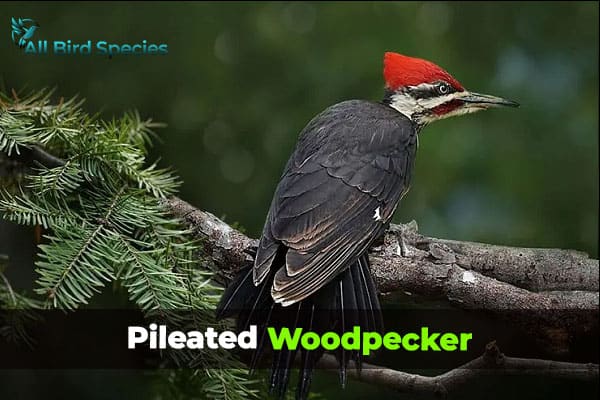
Male and female Pileated Woodpeckers look different on their faces. Males have a red forecrown and a red stripe on their faces, while females have a black forecrown and black stripe.
Pileated Woodpeckers are vocal birds, often making long piping calls and shorter “wuk-wuk” or “cuk-cuk” sounds.
They make nesting holes in dead deciduous or coniferous trees and create a new cavity every breeding season. Female Pileated Woodpeckers lay three to five eggs per clutch. The eggs take 15 to 18 days to hatch, and the baby birds stay in the nest for 24 to 31 days after hatching.
Pileated Woodpeckers mainly eat carpenter ants but also feed on other insects like different types of ants, flies, woodboring beetles, caterpillars, grasshoppers, termites, and cockroaches. They also eat fruits and nuts.
4. White-headed Woodpecker
- Scientific name – Dryobates albolarvatus
- Lifespan – 3 years (average)- 4 years (maximum recorded)
- Size – 8.3 to 9.1 in
- Weight – 1.9 to 2.3 oz
- Wingspan – 16.9 in
- Status – Least concern
The White-headed Woodpecker is one of the most unique-looking woodpeckers in North America. This medium-sized woodpecker has a white head and black body, with white patches on its wings that are especially noticeable in flight. Males have a red patch on the back of their heads, which females lack.

White-headed Woodpeckers make a sharp, rapid “pee-kik” or “pee-kik-kik” call.
They nest in dead pine or fir trees or dead parts of live trees. They usually don’t reuse the same nesting cavity each year but may build a new one in the same tree. Females lay two to nine eggs per clutch. The eggs hatch after 14 days, and the baby birds stay in the nest for 26 days after hatching.
Their main food source is pine seeds, especially large ones. They also eat sap from sap wells and insects like cicadas, beetles, ants, and termites.
The White-headed Woodpecker is not a conservation concern. Their population has been increasing by about 1.1% each year since 1968, and the total breeding population is estimated to be around 240,000 individuals.
5. Lewis’s Woodpecker
- Scientific name – Melanerpes lewis
- Lifespan – 10 years
- Size – 10.2 to 11 in
- Weight – 3.1 to 4.9 oz
- Wingspan – 19.3 to 20.5 in
- Status – Least concern
Lewis’s Woodpeckers in Washington is a reasonably large woodpecker with interesting colors. They have dark green upperparts, pinkish-red underparts, a red face, and a grey collar around their neck.

Lewis’s Woodpeckers are relatively quiet but make a series of loud “churr” calls.
They do not make their nests. Instead, they use old cavities made by other woodpeckers or crevices and holes in dead and dying trees, rarely nesting in live trees. They often reuse the same nesting hole for many years. Female Lewis’s Woodpeckers lay five to nine eggs per clutch. The eggs incubate for 12 to 16 days, and the baby birds stay in the nest for 28 to 34 days after hatching.
Lewis’s Woodpeckers feed on nuts, fruits, and insects.
Lewis’s Woodpecker is at risk of extinction if conservation measures are not taken. Their population has decreased by about 48% over the past five decades, with an estimated total breeding population of 82,000 individuals.
6. Black-backed Woodpecker
- Scientific name – Picoides arcticus
- Lifespan – 8 years
- Size (average) – 9.1 in
- Weight – 2.1 to 3.1 oz
- Wingspan – 15.8 to 16.5 in
- Status – Least concern
The Black-backed Woodpeckers in Washington is a dark, medium-sized woodpecker with three toes, similar to the American Three-toed Woodpecker. They have black upperparts with white wing spots and a black head with a single white stripe below the eye. Their underparts are white, their flanks are barred, and their outer tail feathers are white. Males have a yellow patch on the crown, while females have a black crown.

Their typical calls are high-pitched, sharp “kyik” and “pik” sounds.
Black-backed Woodpeckers create nesting cavities in small dead trees, usually in areas with many larger trees, and rarely nest in dead parts of live trees. They make a new nesting cavity each time they need to lay eggs. The eggs are incubated for 12 to 14 days, and the nestlings leave the nest after an additional 22 to 26 days.
7. American Three-toed Woodpecker
- Scientific name – Picoides dorsalis
- Lifespan – 6 years
- Size – 8.3 to 9.1 in
- Weight – 1.6 to 2.4 oz
- Wingspan – 14.6 to 15.3 in
- Status – Least concern
The American Three-toed Woodpecker is a small bird found in North America. It’s called “three-toed” because it has three toes on each foot, unlike most other woodpeckers which have four.
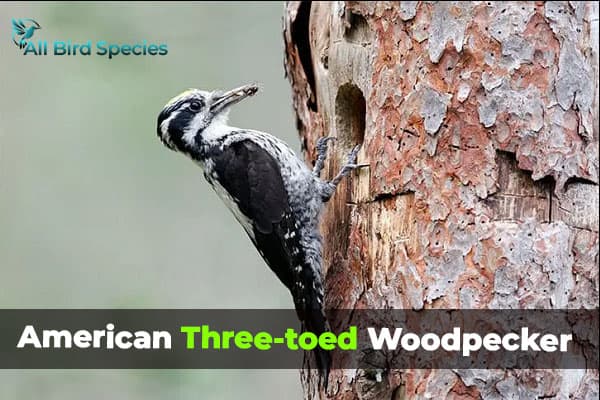
These woodpeckers are mostly black with white markings on their wings and back. They have white spots on their wings and black bars on their tails. The males have a yellow patch on their heads.
They make two kinds of sounds: a nasal “klimp” and a sharp “pik”.
They like to build their nests in dead trees or parts of live trees by digging holes. They make a new hole each year. They lay eggs in the holes, usually three to seven at a time. The eggs take about 12 to 14 days to hatch, and the baby birds stay in the nest for about 22 to 26 days.
These woodpeckers eat beetle larvae, especially bark beetle larvae. They also eat other kinds of beetles, spiders, moth pupae, and ant larvae. Sometimes they drink sap from trees.
The American Three-toed Woodpecker is not in danger of dying out because their numbers have been going up for the past fifty years. There are about 1.6 million of them.
8. Northern Flicker
- Scientific name – Colaptes auratus
- Lifespan – 9 years (maximum recorded)
- Size – 11 to 12.2 in
- Weight – 3.9 to 5.6 oz
- Wingspan – 16.5 to 20.1 in
- Status – Least concern
The Northern Flicker is a big woodpecker with beautiful patterns on its wings and tail. Its name comes from the way its wing and tail colors look like a flickering flame when it flies. There are two kinds of Northern Flickers: the red-shafted and yellow-shafted types. Woodpeckers in Washington State, you’ll mostly find the red-shafted ones.

They have light-colored bellies with black spots, and their backs are gray-brown with black stripes. They also have a white patch on their rear end and a black patch on their throat. Their faces are gray, and they have a red stripe near their beaks. Their flight and tail feathers are also red. The females don’t have the red stripe near their beaks like the males do.
Northern Flickers usually make their homes in holes in trees that are either dead or hurt. Sometimes they nest in holes in banks. They often reuse their old nests. When they lay eggs, females usually lay between five to eight eggs each time. It takes about 11 to 13 days for the eggs to hatch, and then the baby birds leave the nest around 24 to 27 days later.
They mostly eat ants and beetles, but they also like other bugs like butterflies, moths, and flies. Sometimes they eat fruits, berries, seeds, and even snails.
9. Red-breasted Sapsucker
- Scientific name – Sphyrapicus ruber
- Lifespan – 5 years (maximum recorded)
- Size – 7.9 to 8.7 in
- Weight – 1.9 to 2.2 oz
- Wingspan – 14.6 to 16 in
- Status – Least concern
The Red-breasted Sapsucker is a stylish-looking woodpecker that’s not too big. They stand out with their red heads and chests, along with a white patch near their beaks. Their backs are dark with some white spots, and they have long white patches on their wings.
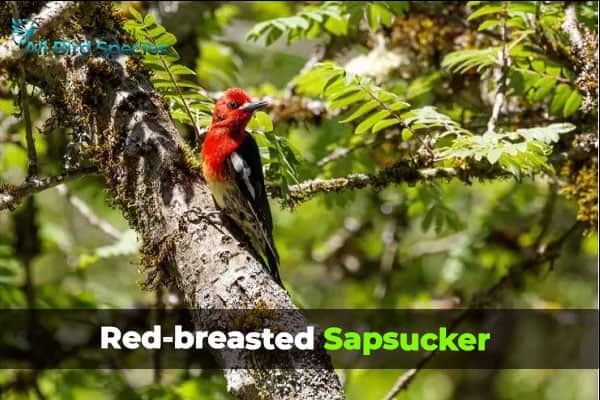
Their bellies are kind of grayish-white with dark lines, and sometimes they have a yellowish tint on their bellies.
These birds make a bunch of different sounds, but the one you’ll hear most often is a rough “weep.”
When it’s time to make a nest, Red-breasted Sapsuckers carve out a hole in a tree that’s either dead or has some dead parts. They usually pick the same tree for nesting year after year, but they don’t reuse old nest holes.
The lady sapsuckers lay a bunch of eggs, usually between four to seven at a time. It takes about 14 to 15 days for the eggs to hatch, and then the baby birds leave the nest about 23 to 28 days later.
They eat sap, bugs like ants, flies, beetles, other small critters, seeds, and fruit.
10. Williamson’s Sapsucker
- Scientific name – Sphyrapicus thyroideus
- Lifespan – 6 years (maximum recorded)
- Size – 8.3 to 9.8 in
- Weight – 1.6 to 1.9 oz
- Wingspan – 17 in
- Status – Least concern
The Williamson’s Sapsucker is a medium-sized woodpecker that looks pretty sharp. One cool thing about them is that males and females look quite different from each other.
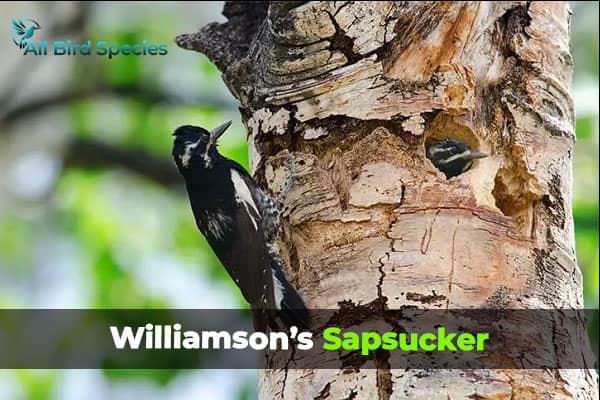
The guys have blackheads with two white stripes and black backs with big white patches on their wings. They’ve got a red spots on their throats, black chests, and yellow bellies.
The ladies, on the other hand, are brown with black-and-white stripes on their backs. They have brown heads with a dark patch on their chests. Their throats have a smaller, less bright red spot, and they also have yellow bellies. Both guys and gals have white patches on their rears.
Williamson’s Sapsuckers aren’t big talkers, but you might hear them make a nasal “chyaah” sound sometimes.
When it’s time to make a home, they drill a hole in a live tree that’s got some fungus on it. They usually come back to the same tree every year but make a new hole each time. The lady sapsuckers lay between three to seven eggs each time. It takes about 12 to 14 days for the eggs to hatch, and then the baby birds stay in the nest for about 21 to 28 days.
Check Our Previous Articles:
11. Red-naped Sapsucker
- Scientific name – Sphyrapicus nuchalis
- Lifespan – 4 years (maximum recorded)
- Size – 7.5 to 8.3 in
- Weight – 1.1 to 2.3 oz
- Wingspan – 16.1 to 16.9 in
- Status – Least concern
The Red-naped Sapsucker is a small and clever-looking bird. Their backs are black with big white stripes on their wings. Their heads have black and white stripes too, and their bellies are kind of dirty-looking with white and black spots on the sides. Sometimes you might see a yellow tint on their bellies. The guys have red patches on their throats, heads, and the back of their necks.
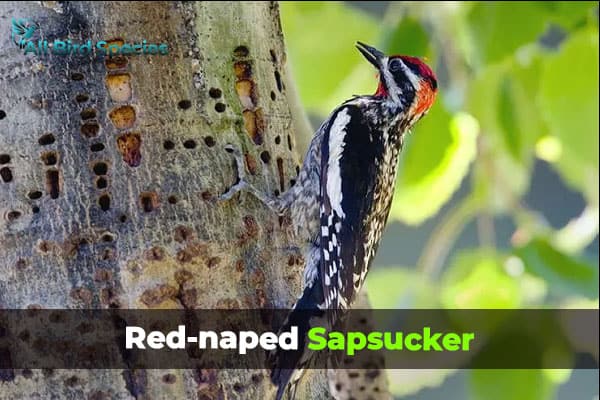
But the gals have a white patch under their beaks, a small red spot on their throats, a red spot on their heads, and either a red or white spot on the back of their necks.
Red-Naped Sapsuckers are pretty chatty birds, and their usual sound is a loud “waaa.”
When it’s time to make a home, they dig holes in dead trees or parts of live trees that aren’t doing too well. They might use the same hole for years, or if they decide to change, they usually pick a new spot on the same tree.
The lady sapsuckers lay between three to seven eggs, and it takes about eight to twelve days for them to hatch. Once the babies are born, they leave the nest after about 23 to 32 days.
Frequently Asked Questions about Woodpeckers in Washington
Q1. What types of woodpeckers are in Washington state?
In Washington state, you can find several types of woodpeckers, including the Northern Flicker, Downy Woodpecker, Hairy Woodpecker, and Pileated Woodpecker.
Q2. What kind of woodpeckers are in DC?
In Washington, DC, you’ll commonly spot species like the Northern Flicker, Downy Woodpecker, Hairy Woodpecker, and occasionally the Pileated Woodpecker.
Q3. Which is the most common woodpecker?
The most common woodpecker species varies by region, but generally, the Downy Woodpecker tends to be one of the most widespread and frequently seen across North America.
Q4. Is it rare to see woodpeckers in Washington?
Woodpeckers are not typically considered rare, especially in wooded or forested areas. Depending on the species and location, they can be quite common and easily spotted, especially if you pay attention to their distinctive drumming sounds or observe them foraging on trees.





